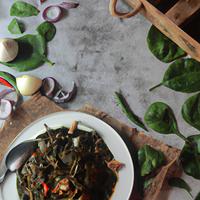
1 serving (100 grams) contains 37 calories, 3.7 grams of protein, 0.2 grams of fat, and 7.3 grams of carbohydrates.

Log this food in SnapCalorie

Nutrition Information
Calories |
88.1 | ||
|---|---|---|---|
% Daily Value* |
|||
| Total Fat | 0.5 g | 0% | |
| Saturated Fat | 0.2 g | 1% | |
| Polyunsaturated Fat | 0 g | ||
| Cholesterol | 0 mg | 0% | |
| Sodium | 35.7 mg | 1% | |
| Total Carbohydrates | 17.4 g | 6% | |
| Dietary Fiber | 4.3 g | 15% | |
| Sugars | 1.2 g | ||
| protein | 8.8 g | 17% | |
| Vitamin D | 0 mcg | 0% | |
| Calcium | 392.9 mg | 30% | |
| Iron | 6.4 mg | 35% | |
| Potassium | 704.8 mg | 14% | |
* Percent Daily Values are based on a 2,000 calorie diet. Your daily values may be higher or lower depending on your calorie needs.
Food Attributes
Source of Calories
About Daun singkong
Daun singkong, or cassava leaves, are a staple in Indonesian cuisine and are widely used across Southeast Asia and Africa. These vibrant green leaves come from the cassava plant, which is also known for its starchy root. Rich in nutrients, daun singkong is an excellent source of fiber, vitamins A and C, and minerals like calcium and iron. It’s particularly valued for promoting digestion, boosting immunity, and supporting bone health. Typically cooked as a side dish or blended into soups and stews, daun singkong must be boiled thoroughly to remove naturally occurring cyanogenic compounds, which can be toxic if not properly prepared. While nutritious, preparation often involves high-fat ingredients like coconut milk, adding calories to the dish. When prepared mindfully, daun singkong can be a delicious and healthy addition to your diet, offering both flavor and nourishment.



